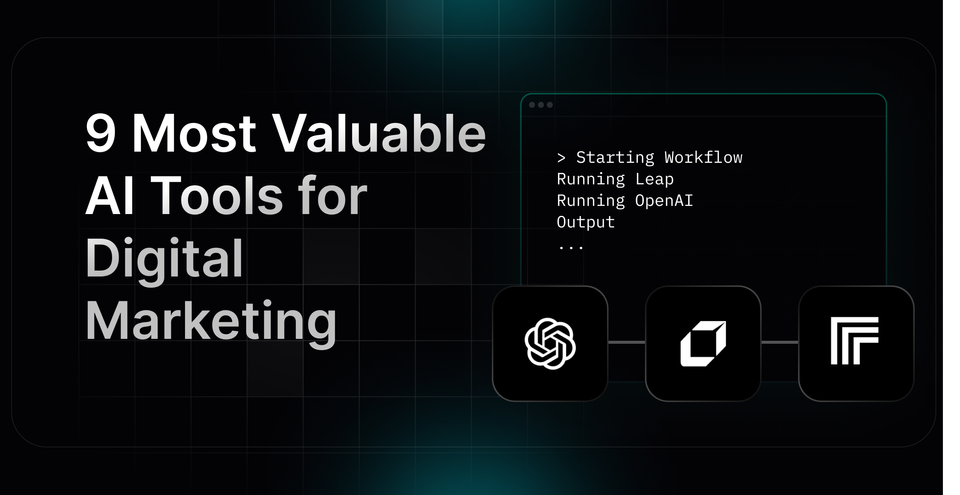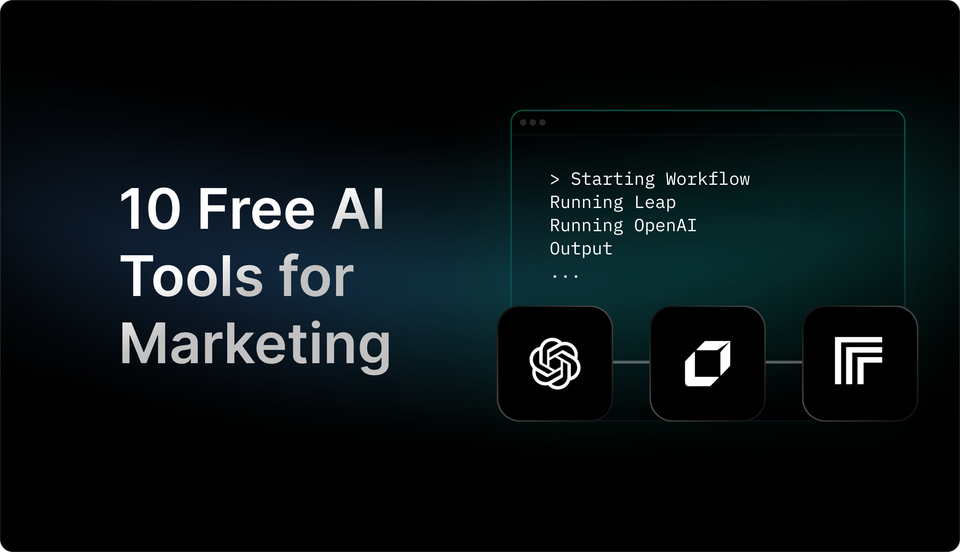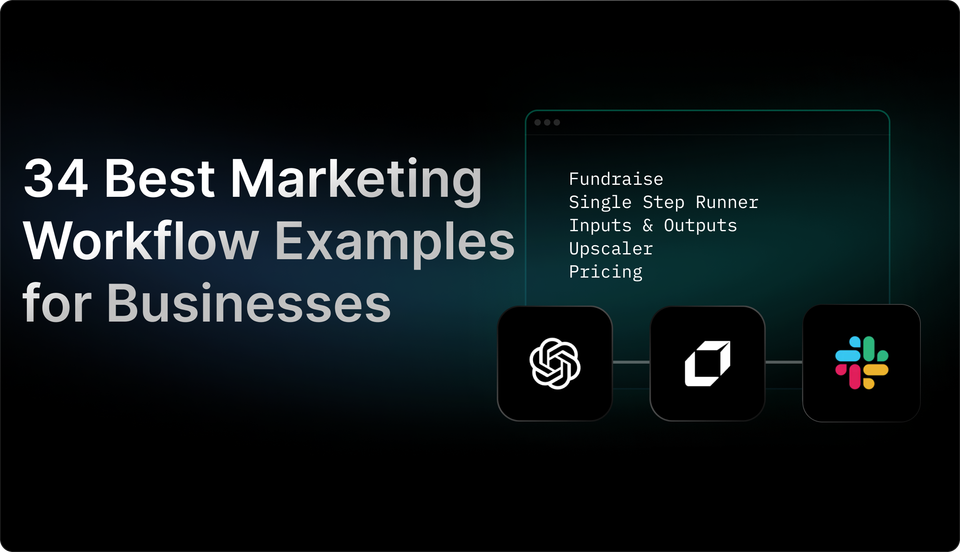15 Marketing Workflow Examples That Get Conversions
Streamline marketing workflow for efficiency and success. Optimize collaboration, enhance productivity, and achieve marketing goals seamlessly.

In today's fast-paced digital world, businesses are constantly striving to stay ahead of their competition and reach their target audience effectively. To achieve this, a well-structured and organized marketing workflow is essential. A marketing workflow acts as a roadmap, guiding businesses through the various stages of planning, executing, and evaluating their marketing campaigns. It ensures that every task is completed efficiently, deadlines are met, and goals are achieved.
A successful marketing workflow involves a series of interconnected steps that seamlessly flow from one stage to another, allowing businesses to maximize their marketing efforts. From conducting market research and creating compelling content to implementing strategies and measuring results, a well-designed marketing workflow streamlines the entire process. By leveraging the power of automation and data-driven insights, businesses can optimize their marketing strategies, make informed decisions, and ultimately drive growth.
So, if you're ready to take your marketing efforts to the next level and unlock the full potential of your business, join us as we dive deep into the world of marketing workflow. Stay tuned to discover the key principles, tips, and tools that can revolutionize your marketing game and help you achieve remarkable results.

What Is A Marketing Workflow?

Marketing workflow refers to the systematic series of steps and activities that are undertaken to complete a marketing task or project. It is a structured and repeatable process that ensures efficiency, collaboration, and effectiveness in executing marketing campaigns and strategies.
Navigating the Marketing Landscape
At its core, a marketing workflow is a roadmap that guides marketers through the various stages of a project, from planning and ideation to execution and analysis. It provides a clear and organized path for marketers to follow, ensuring that everyone involved in the process is aligned and working towards the same goals.
Essential Elements
The key elements of a marketing workflow typically include goal setting, defining target audience, content creation, design and development, distribution and promotion, and performance tracking. Each of these stages has its own set of tasks and deliverables, and the workflow ensures that they are executed in a logical and timely manner.
Efficiency in Action
Having a well-defined marketing workflow offers several benefits. Firstly, it increases efficiency by streamlining the process and eliminating unnecessary steps or redundancies. By clearly establishing roles and responsibilities, it also enhances collaboration among team members, promoting effective communication and coordination.
Consistency Matters
A marketing workflow helps maintain consistency and brand identity across different campaigns and channels. It ensures that all marketing materials adhere to the brand guidelines and messaging, resulting in a cohesive and unified brand presence.
Metrics and Insights
A marketing workflow provides a framework for tracking and measuring the success of marketing initiatives. By setting clear objectives and metrics at the start of a project, marketers can easily evaluate the effectiveness of their efforts and make data-driven decisions for future campaigns.A marketing workflow is a strategic and structured process that guides marketers through the various stages of a project, enabling them to plan, execute, and analyze marketing campaigns with efficiency and effectiveness. By following a defined workflow, marketers can streamline their efforts, improve collaboration, maintain brand consistency, and drive better results.
Related Reading
- Content Marketing Workflows
- Ai For Small Business Marketing
- Email Marketing Workflows
- Digital Marketing Workflow

How Marketing Workflows Help To Streamline and Automate Marketing Tasks

A marketing workflow refers to the systematic and organized process of completing marketing tasks and activities. It involves the coordination of various marketing activities, such as planning, creating content, executing campaigns, and analyzing results, to achieve specific marketing objectives. By implementing a marketing workflow, businesses can streamline and automate their marketing tasks, resulting in increased efficiency and productivity. Here are some ways a marketing workflow can help in this regard:
1. Standardization
A marketing workflow provides a standardized framework for executing marketing tasks. It ensures that every team member follows a consistent set of steps and procedures, eliminating confusion and reducing errors. This standardization helps to maintain brand consistency and deliver a cohesive message across various marketing channels.
2. Collaboration and Communication
A well-defined marketing workflow promotes collaboration and effective communication among team members. It clearly defines roles and responsibilities, allowing team members to work together seamlessly. By having a centralized platform or tool, team members can easily share files, provide feedback, and track progress, facilitating better teamwork and efficiency.
3. Time and Resource Management
A marketing workflow enables businesses to allocate resources effectively and optimize their time. By breaking down complex projects into smaller tasks, it becomes easier to assign responsibilities and set deadlines. This helps in avoiding bottlenecks and ensures that tasks are completed in a timely manner. A marketing workflow allows businesses to identify areas where resources can be better utilized or reallocated for maximum impact.
4. Automation and Integration
Marketing workflows can be automated using various marketing tools and software. This automation eliminates repetitive manual tasks, such as scheduling social media posts or sending email campaigns, freeing up time for marketers to focus on more strategic activities. Integrating different marketing tools and platforms within the workflow also helps in streamlining processes and data management, reducing duplication of efforts.
5. Data-driven Decision Making
A marketing workflow provides a systematic approach for collecting and analyzing data throughout the marketing process. By tracking and measuring the performance of various marketing activities, businesses can gain valuable insights into their target audience, campaign effectiveness, and return on investment. These insights enable data-driven decision-making, allowing businesses to optimize their marketing strategies and allocate resources more effectively.
Why should you map and optimize your marketing workflows?
Mapping and optimizing your marketing workflows is essential for ensuring maximum efficiency and effectiveness in your marketing efforts. Here are some reasons why it is important:
1. Identify Bottlenecks and Inefficiencies
Mapping your marketing workflows helps to identify bottlenecks and inefficiencies in the process. By visualizing the entire workflow, you can identify areas where tasks get delayed or where there is a lack of clarity in roles and responsibilities. This allows you to make necessary adjustments and streamline the workflow to optimize efficiency.
2. Improve Collaboration and Communication
Optimized marketing workflows facilitate better collaboration and communication among team members. By clearly defining roles, responsibilities, and expectations, team members can work together more smoothly. This reduces the chances of miscommunication and ensures that everyone is on the same page, leading to improved productivity and better results.
3. Enhance Customer Experience
An optimized marketing workflow helps in delivering a better customer experience. By streamlining processes and reducing delays, businesses can ensure that customers receive timely and consistent communication. This helps in building trust, improving customer satisfaction, and increasing the likelihood of repeat business.
4. Increase Agility and Adaptability
Optimizing marketing workflows allows businesses to be more agile and adaptable in response to changing market conditions. By mapping out the workflow, businesses can better understand the dependencies between tasks and identify areas where adjustments can be made quickly. This flexibility enables businesses to seize new opportunities, respond to customer feedback, and stay ahead of the competition.
5. Measure and Improve Performance
An optimized marketing workflow enables businesses to measure and track the performance of their marketing activities more effectively. By setting clear goals and metrics at each stage of the workflow, businesses can easily assess the success of their campaigns and make data-driven decisions for improvement. This iterative approach helps in optimizing marketing strategies and achieving better results over time.
15 Marketing Workflow Examples That Get Conversions

1. Content Marketing Workflow
This workflow involves researching, planning, creating, and promoting content to attract and engage the target audience.
- It starts with conducting market research and keyword analysis to identify topics that resonate with the audience.
- Then, the content is created and optimized for search engines and user experience.
- It is promoted through various channels, such as social media, email marketing, and guest blogging, to drive traffic and conversions.
This workflow can be tailored to a specific business by aligning content topics with the target audience's interests and needs.
2. Email Marketing Workflow
This workflow consists of capturing leads through opt-in forms, segmenting them based on their interests or behavior, and creating personalized email campaigns.
- It starts with setting up lead capture forms on the website or landing pages to collect email addresses.
- The leads are then segmented into different lists based on their preferences or actions.
- Personalized email campaigns, including welcome emails, drip campaigns, and abandoned cart emails, are designed to nurture leads and guide them towards conversion.
This workflow can be customized by tailoring email content and offers to match the specific needs and pain points of the target audience.
3. Social Media Marketing Workflow
This workflow involves creating a social media strategy, creating and scheduling content, engaging with the audience, and analyzing performance.
- It starts by identifying the target audience's preferred social media platforms.
- Content, including images, videos, and captions, is then created and scheduled for publishing.
- The social media team actively engages with the audience by responding to comments, messages, and reviews.
- Performance metrics, such as reach, engagement, and conversions, are analyzed to optimize future campaigns.
This workflow can be tailored to a specific business by selecting social media platforms that align with the target audience's demographics and interests.
4. Search Engine Optimization (SEO) Workflow
This workflow involves conducting keyword research, optimizing website content, building backlinks, and monitoring performance.
- It starts with identifying relevant keywords that have high search volume and low competition.
- On-page optimization techniques, such as optimizing meta tags, headings, and content, are then implemented to improve search engine rankings.
- Off-page optimization strategies, such as guest blogging and link building, are used to build authoritative backlinks.
- Performance metrics, such as organic traffic, keyword rankings, and conversions, are monitored to refine the SEO strategy.
This workflow can be customized by focusing on keywords and content that are specifically relevant to the business and its target audience.
5. Pay-Per-Click (PPC) Advertising Workflow
This workflow involves setting up PPC campaigns, conducting keyword research, creating compelling ad copy, optimizing landing pages, and analyzing campaign performance.
- It starts with identifying high-converting keywords and creating targeted ad groups.
- Ad copy is then crafted to attract the target audience and encourage clicks.
- Landing pages are optimized to provide a seamless user experience and drive conversions.
- Conversion tracking and analytics tools are used to measure campaign performance and make data-driven optimizations.
This workflow can be tailored to a specific business by selecting keywords and ad targeting options that are aligned with the target audience's interests and demographics.
6. Influencer Marketing Workflow
This workflow involves identifying relevant influencers, building relationships, creating collaborative content, and tracking results.
- It starts with identifying influencers who have a strong following and align with the brand's values and target audience.
- Relationships are built through outreach, collaborations, and product seeding.
- Collaborative content, such as sponsored posts, reviews, or giveaways, is created to promote the brand.
- Performance metrics, such as reach, engagement, and conversions, are tracked to measure the success of influencer partnerships.
This workflow can be customized by selecting influencers who resonate with the specific business's industry, values, and target audience.
7. Conversion Rate Optimization (CRO) Workflow
This workflow involves conducting website audits, analyzing user behavior, implementing A/B testing, and implementing improvements.
- It starts with analyzing user behavior through tools like heatmaps and user recordings to identify areas of improvement.
- A/B testing is then conducted to compare different variations of website elements, such as headlines, call-to-action buttons, and forms, to determine what drives the highest conversion rates.
- Based on the data gathered, improvements are implemented to optimize the website for conversions.
This workflow can be tailored to a specific business by focusing on website elements and user experience factors that are most likely to influence the target audience's decision-making process.
8. Referral Marketing Workflow
This workflow involves setting up referral programs, incentivizing referrals, tracking referrals, and rewarding advocates.
- It starts with designing a referral program that encourages customers to refer their friends and family.
- Incentives, such as discounts, exclusive offers, or loyalty points, are provided to both the referrer and the referred customer.
- Referrals are tracked using unique codes or referral links.
- Advocates who generate a certain number of successful referrals are rewarded with additional perks or recognition.
This workflow can be customized by tailoring the referral program and incentives to match the specific business's products or services and the preferences of its target audience.
9. Webinar Marketing Workflow
This workflow involves planning, promoting, hosting, and following up on webinars to educate and convert the target audience.
- It starts with choosing a webinar topic that addresses the target audience's pain points or interests.
- The webinar is then promoted through various channels, such as email marketing, social media, and website banners.
- During the live webinar, valuable content is delivered, and attendees are encouraged to ask questions and engage.
- After the webinar, follow-up emails are sent to attendees, providing additional resources or offers to further drive conversions.
This workflow can be tailored to a specific business by selecting webinar topics and content that are highly relevant to the target audience's needs and interests.
10. Affiliate Marketing Workflow
This workflow involves recruiting affiliates, providing them with promotional materials, tracking conversions, and rewarding affiliates.
- It starts with identifying potential affiliates who have access to the target audience.
- Affiliates are then recruited and provided with unique affiliate links or promo codes to track conversions.
- Promotional materials, such as banners, product images, or email templates, are made available to affiliates.
- Conversions are tracked using affiliate tracking software, and affiliates are rewarded with commissions or incentives based on their performance.
This workflow can be customized by selecting affiliates who have a strong influence over the specific business's target audience and align with its brand values.
11. Remarketing Workflow
This workflow involves tracking website visitors, segmenting them based on their behavior, creating targeted ads, and optimizing landing pages.
- It starts with implementing remarketing tags on the website to track visitors who have shown interest but left without converting.
- Visitors are then segmented based on their behavior, such as abandoned cart, product page views, or time spent on site.
- Targeted ads are created and displayed to these segmented audiences across various platforms, reminding them of the products or services they were interested in.
- Landing pages are optimized to provide a personalized and seamless experience for remarketed visitors.
This workflow can be tailored to a specific business by segmenting visitors based on their specific actions or interests and delivering targeted ads that address their needs or concerns.
12. Customer Retention Workflow
This workflow involves segmenting customers, nurturing relationships, providing exclusive offers, and measuring customer satisfaction.
- It starts with segmenting customers based on their purchase history, preferences, or engagement level.
- Personalized communication, such as personalized emails, loyalty program updates, or special offers, is then sent to nurture the relationship and encourage repeat business.
- Customer satisfaction surveys or feedback loops are implemented to measure satisfaction and identify areas for improvement.
This workflow can be customized by segmenting customers based on their specific behavior or preferences and tailoring communication and offers to match their interests and needs.
13. Event Marketing Workflow
This workflow involves planning, promoting, hosting, and following up on events to generate leads and conversions.
- It starts with defining event objectives and target audience, choosing a venue, and planning event logistics.
- The event is then promoted through various channels, such as email marketing, social media, and targeted advertising.
- During the event, attendees are engaged through presentations, workshops, or networking opportunities.
- After the event, follow-up emails or calls are sent to nurture leads and drive conversions.
This workflow can be tailored to a specific business by selecting event formats, themes, or locations that align with the target audience's preferences and interests.
14. Direct Mail Marketing Workflow
This workflow involves identifying target recipients, designing personalized mailers, printing and mailing, and tracking response rates.
- It starts with segmenting the target audience based on demographics, purchase history, or interests.
- Personalized mailers, such as postcards, catalogs, or letters, are then designed and printed.
- The mailers are sent to the target recipients, and response rates are tracked using unique codes or personalized URLs.
- Follow-up communication, such as emails or phone calls, can be implemented to nurture leads and drive conversions.
This workflow can be customized by tailoring the design and content of the mailers to match the specific business's brand and the target audience's preferences.
15. Partnership Marketing Workflow
This workflow involves identifying potential partners, building relationships, creating joint campaigns, and measuring results.
- It starts with identifying complementary businesses or influencers who share the same target audience.
- Relationships are built through networking, collaborations, or co-marketing initiatives.
- Joint campaigns, such as giveaways, cross-promotions, or bundled offers, are created to leverage each other's audience and drive conversions.
- Key metrics, such as traffic, conversions, or revenue generated, are tracked to evaluate the success of partnership initiatives.
This workflow can be tailored to a specific business by selecting partners who align with its brand values and have a strong influence over the target audience.
Successful Examples of Marketing Workflows In Various Industries

1. E-commerce
In the e-commerce industry, a successful marketing workflow involves leveraging data-driven strategies to increase customer acquisition and retention. This includes targeting specific customer segments through personalized email campaigns, implementing social media advertising, and optimizing website content to improve search engine visibility. By analyzing customer behavior and preferences, e-commerce businesses can create targeted marketing workflows that effectively drive traffic, convert leads, and generate sales.
2. Healthcare
In the healthcare industry, a successful marketing workflow focuses on building trust and credibility while providing valuable information to patients. This can be achieved through content marketing strategies such as creating informative blog posts, educational videos, and engaging social media content.
Healthcare providers can also implement email marketing campaigns to nurture patient relationships and encourage ongoing engagement. By delivering relevant and timely information, healthcare organizations can establish themselves as thought leaders and attract more patients.
3. Software as a Service (SaaS)
For SaaS companies, a successful marketing workflow involves a combination of inbound and outbound marketing strategies. Inbound marketing tactics like content creation, SEO optimization, and lead nurturing through email campaigns help attract and convert leads.
Outbound strategies such as targeted advertising, cold emailing, and influencer partnerships can help reach a wider audience and generate new leads. By integrating these marketing activities into a cohesive workflow, SaaS companies can effectively drive user acquisition and increase customer retention.
4. Hospitality
In the hospitality industry, a successful marketing workflow focuses on creating memorable experiences for guests and building brand loyalty. This can be achieved through personalized email marketing campaigns, social media engagement, and targeted advertising.
Hospitality businesses can also leverage customer reviews and testimonials to highlight positive experiences and attract new customers. By providing exceptional customer service and consistently delivering on brand promises, hospitality companies can create a marketing workflow that drives customer loyalty and referrals.
5. Financial Services
In the financial services industry, a successful marketing workflow involves building trust, establishing expertise, and nurturing client relationships. Content marketing plays a crucial role in this workflow, with informative blog posts, whitepapers, and webinars helping to educate potential clients.
Email marketing campaigns can be used to provide personalized financial advice and updates, while social media can be leveraged to engage with clients and showcase thought leadership. By combining these marketing activities, financial service providers can effectively attract and retain clients.
6. Retail
In the retail industry, a successful marketing workflow focuses on creating a seamless omnichannel experience for customers. This includes integrating online and offline marketing strategies such as email campaigns, social media promotions, and in-store events.
Retailers can also leverage customer data to personalize marketing communications and offers. By streamlining the customer journey and providing a consistent brand experience across multiple touchpoints, retail businesses can create a marketing workflow that drives customer engagement and increases sales.
7. Nonprofit
For nonprofit organizations, a successful marketing workflow involves building awareness, inspiring action, and fostering donor relationships. Content marketing strategies such as storytelling, blog posts, and social media campaigns can be used to engage and educate the target audience.
Email marketing and fundraising campaigns can help drive donations and ongoing support. By focusing on building a community and communicating the impact of their work, nonprofits can create a marketing workflow that generates donor loyalty and attracts new supporters.
Related Reading
- Marketing Automation Workflows
- Marketing Workflow Management
- Content Marketing Workflow
- Digital Marketing Agency Workflow
- Digital Marketing Workflows
- Marketing Workflow Examples
Common Challenges of Implementing A Marketing Workflow

Implementing a marketing workflow can be a complex and challenging task. It involves coordinating multiple tasks, teams, and tools to ensure a seamless and efficient marketing process. We will discuss some of the common challenges faced in implementing a marketing workflow and how to overcome them.
1. Lack of Clear Communication
Effective communication is essential for the successful implementation of a marketing workflow. It is common for teams to face challenges in ensuring clear and timely communication. This can result in misalignment, confusion, and delays in the workflow.
To overcome this challenge, it is important to establish a centralized communication channel, such as a project management tool or collaboration platform, where teams can share updates, feedback, and important information. Regular meetings and clear guidelines for communication should also be established to ensure everyone is on the same page.
2. Lack of Standardization
Inconsistent processes and workflows can hinder the efficiency of marketing operations. Without standardized processes, teams may waste time and effort on repetitive tasks or struggle to collaborate effectively.
To address this challenge, it is important to define and document standardized marketing processes. This includes clearly outlining each step, assigning responsibilities, and providing guidelines and templates for consistent execution. Regular training and feedback sessions can also help in reinforcing these standardized processes.
3. Difficulty in Managing Workload
Marketing teams often face the challenge of managing a large volume of tasks and projects simultaneously. This can lead to bottlenecks, missed deadlines, and overall inefficiency.
To tackle this challenge, it is crucial to prioritize tasks and allocate resources effectively. Implementing a project management tool with task tracking capabilities can help in visualizing the workload and assigning tasks based on priorities. Setting realistic deadlines and regularly reviewing the progress can also ensure timely completion of tasks.
4. Lack of Integration with Tools and Systems
Marketing workflows involve the use of various tools and systems, such as CRM, marketing automation, social media management, and analytics platforms. Integrating these tools and systems seamlessly can be a major challenge.
To overcome this, it is important to carefully evaluate and select tools that have native integrations or provide APIs for integration. An integrated marketing technology stack can streamline data flow, eliminate manual data entry, and enable real-time reporting and analysis.
5. Resistance to Change
Implementing a new marketing workflow often requires changes in processes, responsibilities, and technologies. Resistance to change from team members and stakeholders can be a significant challenge.
To address this challenge, it is important to involve key stakeholders in the decision-making process and communicate the benefits of the new workflow. Providing training and support to team members during the transition phase can also help in overcoming resistance to change.
Implementing a marketing workflow can be a complex undertaking, but by addressing these common challenges, organizations can streamline their marketing processes and improve overall efficiency. Clear communication, standardized processes, effective workload management, seamless integration with tools, and addressing resistance to change are key factors to consider when implementing a successful marketing workflow.
10 Best Practices for Marketing Workflow Management

1. Define clear goals and objectives
Having a clear understanding of the goals and objectives of your marketing workflow is essential for effective management. This includes setting specific, measurable, attainable, relevant, and time-bound (SMART) goals that align with your overall marketing strategy.
2. Establish a standardized workflow process
Creating a standardized workflow process helps streamline your marketing operations and ensures consistency across different campaigns and teams. This process should include steps such as ideation, planning, content creation, review and approval, distribution, and analysis.
3. Assign clear roles and responsibilities
Assigning clear roles and responsibilities to team members promotes accountability and ensures that everyone knows their specific tasks and deadlines. This includes designating a project manager or coordinator to oversee the workflow and communicate with all stakeholders.
4. Utilize marketing automation tools
Leveraging marketing automation tools can significantly improve efficiency and productivity in managing your workflow. These tools can automate repetitive tasks, such as email marketing, social media scheduling, and data analysis, freeing up time for more strategic activities.
5. Foster effective communication and collaboration
Effective communication is vital for successful marketing workflow management. Encourage open and transparent communication among team members, providing regular updates, and utilizing collaboration tools to streamline communication and file sharing.
6. Implement a centralized asset management system
Maintaining a centralized asset management system ensures easy access to all marketing assets, such as images, videos, and documents. This eliminates time wasted searching for files and promotes consistency in brand messaging and design.
7. Establish a feedback loop
Creating a feedback loop allows for continuous improvement in your marketing workflow. Regularly seek feedback from team members, clients, and customers to identify areas for optimization and make necessary adjustments to the process.
8. Monitor and analyze performance metrics
Tracking key performance metrics, such as conversion rates, click-through rates, and return on investment, provides valuable insights into the effectiveness of your marketing efforts. Use these metrics to evaluate the success of your workflow and make data-driven decisions.
9. Conduct regular performance reviews and optimization
Regularly evaluate your marketing workflow to identify bottlenecks, inefficiencies, and areas for improvement. Conduct performance reviews to assess the effectiveness of your processes and make necessary adjustments to optimize workflow efficiency.
10. Stay agile and adaptable
The marketing landscape is constantly evolving, so it's crucial to stay agile and adaptable in managing your workflow. Embrace new technologies, trends, and strategies, and be open to making changes as needed to keep your marketing workflow effective and efficient.
Scaling Your Marketing Workflows As Your Business Grows

As businesses grow and evolve, it becomes crucial to scale marketing workflows to keep up with the increasing demands of the organization. This involves streamlining and automating processes, optimizing resources, and aligning marketing efforts with business objectives. Here are some key strategies to scale marketing workflows effectively.
1. Establish Clear Goals and Objectives
Before scaling marketing workflows, it is important to have a clear understanding of the business goals and objectives. This allows marketers to align their efforts and focus on activities that drive results. By defining key performance indicators (KPIs) and setting measurable goals, marketing teams can prioritize their efforts and ensure that their workflows are optimized for business growth.
2. Define and Document Processes
To scale marketing workflows, it is essential to have well-defined and documented processes. This includes outlining the steps and responsibilities involved in each marketing activity, from lead generation to customer retention. By documenting processes, businesses can ensure consistency, improve collaboration, and easily train new team members as the organization grows.
3. Leverage Automation Tools
As the volume of marketing activities increases, manual execution becomes inefficient and time-consuming. Implementing marketing automation tools can significantly improve workflow scalability. These tools can automate repetitive tasks, such as email campaigns, social media posting, and lead nurturing, freeing up time for marketers to focus on strategic initiatives. By automating workflows, businesses can increase efficiency, reduce errors, and scale their marketing efforts without sacrificing quality.
4. Embrace Data-Driven Decision Making
Data-driven decision-making is a critical aspect of scaling marketing workflows. By leveraging analytics and tracking tools, businesses can gain valuable insights into the performance of their marketing campaigns. This allows marketers to identify what works and what doesn't, optimize their strategies, and allocate resources to the most effective channels. Data-driven decision-making enables businesses to continuously improve their marketing workflows and drive measurable results.
5. Foster Collaboration and Communication
As businesses grow, it becomes essential to foster collaboration and communication within the marketing team and across departments. Implementing project management tools, such as Trello or Asana, can enhance transparency, streamline communication, and ensure that everyone is on the same page. By fostering a collaborative work environment, businesses can align their marketing workflows with the overall business strategy, improve efficiency, and deliver a consistent brand experience.
6. Continuously Measure and Iterate
Scaling marketing workflows is an iterative process that requires continuous measurement and improvement. By regularly analyzing the performance of marketing campaigns and monitoring key metrics, businesses can identify areas for optimization and make data-driven adjustments. This allows teams to adapt their workflows to changing market conditions, customer preferences, and business objectives. Continuous measurement and iteration ensure that marketing workflows are always aligned with the evolving needs of the business.
Scaling marketing workflows is crucial for businesses to keep pace with growth and evolution. By establishing clear goals, defining processes, leveraging automation tools, embracing data-driven decision-making, fostering collaboration and communication, and continuously measuring and iterating, businesses can effectively scale their marketing efforts. Implementing these strategies ensures that marketing workflows remain efficient, scalable, and aligned with the overall business strategy, enabling organizations to achieve sustainable growth.
Create Game Changing Automations Today With Leap’s AI Workflows
In today's fast-paced business environment, efficiency is key. As a marketer, you know just how important it is to streamline your workflow and eliminate repetitive tasks. That's where Leap Workflows comes in. With the power of AI, Leap Workflows enables you to automate your marketing processes and supercharge your productivity.
1. Enhance your productivity with AI automation
Marketing workflows can be complex and time-consuming. With Leap Workflows, you can automate repetitive tasks, allowing you to focus on more strategic initiatives. From lead generation to content creation, email campaigns to social media management, AI automation can handle it all. By integrating the tools you love with best-in-class AI models, Leap Workflows empowers you to work smarter, not harder.
2. Supercharge your existing tools with AI integrations
Leap Workflows seamlessly integrates with popular tools like OpenAI and Microsoft, enabling you to harness the power of AI without leaving your preferred platforms. Whether you need AI-generated content, voice translations, or call transcriptions, Leap Workflows has got you covered. Say goodbye to tedious manual work and unlock the potential of AI with just a few clicks.
3. Create sophisticated AI automations with no-code
You don't need to be a coding expert to leverage the power of AI. Leap Workflows offers a no-code solution, allowing you to create custom AI automations without writing a single line of code. Its intuitive interface makes it easy for marketers of all skill levels to build and deploy complex workflows. From summarizing documents to automating SEO tasks, the possibilities are endless.
4. Connect the tools you love
Leap Workflows partners with leading platforms like Zapier and Vercel, giving you the flexibility to connect your favorite tools seamlessly. Whether you're using project management software, CRM platforms, or social media management tools, Leap Workflows can bridge the gap and bring all your tools together in one centralized platform. Say goodbye to switching between multiple apps and streamline your workflow with ease.
5. Try Leap Workflows for free today
Ready to supercharge your marketing workflow? Try Leap Workflows for free today and experience the power of AI automation. With its extensive range of AI models and seamless integrations, Leap Workflows empowers you to automate anything and everything. From content creation to lead nurturing, take your marketing efforts to new heights with Leap Workflows.
Leap Workflows is the ultimate solution to automate your marketing workflow. With its no-code AI automation capabilities, seamless integrations, and a wide range of AI models, Leap Workflows empowers marketers to work smarter and more efficiently. Don't miss out on the opportunity to revolutionize your marketing processes - try Leap Workflows for free today and unlock the true potential of AI automation.




